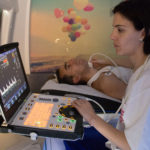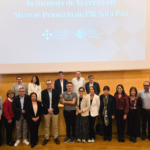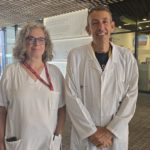
Researchers from the Institut de Recerca Sant Pau (IR Sant Pau), in collaboration with the Headache and Neuralgia Unit at Hospital de Sant Pau, the Universitat Autònoma de Barcelona, and the Universitat Pompeu Fabra, have published a pioneering study in the journal Headache on the use of deep brain stimulation (DBS) for treating chronic refractory cluster headache (CRCH). This research, the first of its kind to analyse the mechanisms of action through connectomics—an emerging field studying networks and connections between brain areas to understand how they interrelate and function together—offers new findings that could mark a breakthrough in the treatment of this highly debilitating disease.
Chronic cluster headache is a rare condition with severe symptoms that are difficult to treat. It is estimated that only 10% of patients with cluster headache—already an uncommon condition affecting approximately 1 in 1,000 people—develop a chronic form. Of this small group, only 10% are unresponsive to any available treatment, becoming “refractory” patients. Those affected typically experience multiple daily episodes of intense pain, which interfere with their personal and professional lives, causing significant economic and emotional impact for both the patients and the healthcare system.
The study included 14 patients with an average age of 42 years, all impacted by CRCH. DBS therapy was applied to the ventral area of the midbrain, a strategic stimulation point located in the lateral region of the ventral tegmental area (VTA), identified in the study as a “sweet spot” for generating a positive response. Clinical outcomes were monitored at intervals of 3, 6, 12, and 24 months, providing detailed data on the long-term efficacy of the intervention.
Clinical outcomes and headache burden reduction
The study used the “headache burden” (HAL) as the primary success indicator, a composite index considering the frequency, duration, and severity of pain attacks. The results showed a significant reduction in HAL levels among the 14 patients: from an average of 424 points at the start of the study, decreasing to 146 points at 24 months, representing an average reduction of 65% in the total burden of the disease.
Within the studied group, more than half (58%) of the patients achieved a reduction of over 50% in their HAL, experiencing considerable improvements in their quality of life, with the number of crises decreasing from five or six daily to just one or two crises per week. An additional 21% of patients showed a partial response to treatment, reducing their burden by 30–50%, while another 21% achieved minimal improvement (less than 30%).
Innovation in treatment and advances in brain connectomics
In addition to the notable clinical success, this research stands out for its pioneering analysis of the brain pathways involved in the improvement of patients treated with DBS. Using connectomics, the team identified the possible involvement of corticorubral tracts, a network of connections between the cerebral cortex, the red nucleus—located in the midbrain—and the cerebellum, which appear to play a key role in the beneficial effects of DBS. This analysis provides a better understanding of how and why some patients respond to the treatment and lays the groundwork for future research aimed at optimising candidate selection and improving clinical outcomes.
Dr Juan Ángel Aibar, from the Neurosurgery Research Group at IR Sant Pau and co-author of the study, explains that “DBS offers hope for those CRCH patients who find no relief in any other therapy. Advancing our understanding of the brain pathways activated by this intervention helps us comprehend the mechanisms behind its effectiveness, which could, in the future, allow us to identify the most suitable patients for this type of treatment.”
A path to excellence in treatments for refractory diseases
Hospital Sant Pau is currently the only centre in Spain with an established DBS programme for treating refractory cluster headache. This advance reflects the commitment of the hospital and IR Sant Pau to positioning themselves as a reference centre for treating refractory diseases—those for which all conventional therapies have failed.
The authors of the study highlight that while the treatment has shown high effectiveness in many patients, it is important to maintain realistic expectations, as this therapy does not cure the disease but significantly reduces its impact. The positive results observed in this research, particularly in male patients, also underline the need for further studies investigating how biological differences might affect the response to therapy in men and women.
Future perspectives
The Sant Pau team will continue its research, seeking to refine the therapies available for patients with chronic refractory cluster headache and deepen the understanding of DBS mechanisms of action. According to their estimates, there are still individuals in Spain who could benefit from this therapy but are not currently receiving appropriate treatment due to a lack of awareness about this innovative option.
This study reinforces the importance of reference centres and underscores the role of dissemination and education within the medical and scientific communities to ensure that patients with extreme and unmet needs can access cutting-edge care.
Reference article:
Aibar-Durán, J. Á., González, N., Mirapeix, R. M., Sánchez-Mateos, N. M., Arsequell, C. R., Pichot, M. B., … Rodríguez Rodríguez, R. (2024). Deep brain stimulation for chronic refractory cluster headache: A case series about long-term outcomes and connectivity analysis. Headache. doi:10.1111/head.14875





















